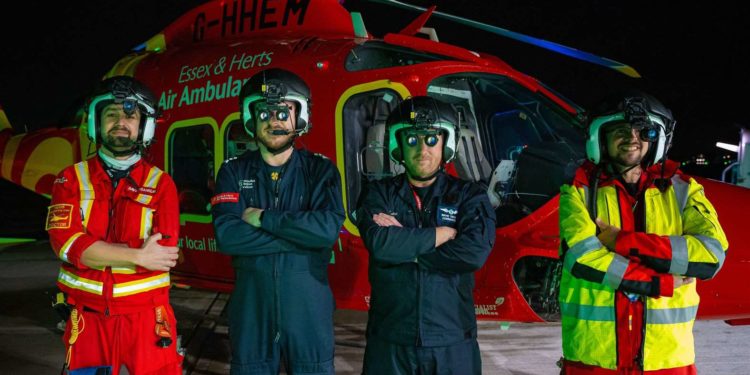The air ambulance helicopter that serves the Bishop’s Stortford area can now attend emergencies round the clock after its pilots and medics completed their night flying training.
Previously, the Essex and Herts Air Ambulance Trust (EHAAT) could only respond to night-time calls by using one of its five rapid response vehicles (RRVs), which carry the same life-saving equipment as the two choppers, which are based at North Weald and Earls Colne.
But now the AW169 ‘copter stationed at the charity’s North Weald airbase can help to deliver its 24/7 pre-hospital critical care service to patients in the two counties after the helicopter emergency medical service (HEMS) teams completed their necessary night vision imaging system (NVIS) training.
It attended its first night mission, a car crash in the Southend area, on the evening of Saturday January 14. Because Southend University Hospital was nearby, the patient was taken there by land ambulance.
Night flying is a landmark development for EHAAT and a further step in its strategic aim to provide the highest possible standards of clinical care. As well as reducing its reliance on the RRVs, which take longer to attend, it will increase its ability to get its HEMS teams to incidents more effectively, particularly during shorter daylight hours in winter.
To fly in the dark, the crew use night vision goggles, which are calibrated to meet the specific vision requirements of the individual and attached to the front of their flight helmets.
The pilots’ goggles worn are binocular, with two tubes, one per eye, that enhance the available light. This enables them to see obstructions such as wires, pylons and buildings while flying in darkness and to land in unlit areas. The pre-hospital care doctor and critical care paramedic on board each flight use a monocular, single-tube goggle.
Paul Curtis, EHAAT’s aviation and operations director, said: “This is a very exciting new development to the life-saving service provided by the charity. Flying at night enables EHAAT to respond faster, delivering our critical care team to the incidents at which they are needed the most.”
It costs EHAAT more than £750,000 a month to operate its free service. This would not be possible without the generosity and goodwill of people in Essex and Hertfordshire as the charity receives limited direct funding from the Government and none from the National Lottery.
Each of its HEMS teams consist of two pilots, a pre-hospital care doctor and a critical care paramedic. In 2021 these teams attended 2,554 missions – 539 road traffic collisions, 958 medical emergencies and 1,057 accidental injuries and other trauma incidents – with each one costing around £2,200. Of these, just over half (1,366) were delivered by air ambulance.
Credit: Source link




